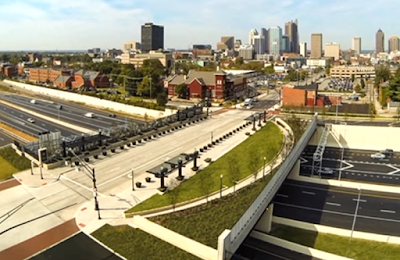To celebrate the 50th anniversary of the Department of Transportation (DOT), Secretary Anthony Foxx presented at the Center for American Progress on Bridging the Divide: A Transportation Plan for the 21st Century on Wednesday, March 30. His speech outlined the current and historical decision making processes that were used to determine the locations of the transportation network. Sec. Foxx made an impassioned and at times, rather blunt, case for making our transportation system a way to connect people rather than divide them.
Sec. Foxx pointed out that many transportation decisions happened prior to the passage of the Civil Rights Act and the Voting Rights Act. Decision makers at the time thought of minority and low income communities as the community of least resistance; that thinking is reflected in how the transportation system was built in the early days and we see those values embedded in the infrastructure that is still used today.
Sec. Foxx went on to quote Thomas MacDonaldand Robert Moses, two leading transportation and planning thinkers of their time. MacDonald said his goal was to get farmers out of the mud and advocated to displace people saying “destroying low income areas with highways would in effect serve a higher and more legitimate purpose converting them into a public asset.” Robert Moses said “plowing freeways through low income areas would make Baltimore a healthier city in the long run.”
I say all of this as background for the transportation system that we currently have. Anyone who has driven on a highway in or around a major city has seen this effect. Every time I drive to visit family in Pennsylvania I see the effects the highway has on the communities that surround it. The image below, taken from Google Maps, is the view of I-95 as you drive through Chester, Penn. I often feel as if I’m driving through the resident’s neighborhood and can imagine that it might have once been a thriving community with homes where the highway currently resides.
I-95 was built in the 1960’s and Chester was home to 66,000 people in the 1950’s. Today Chester is home to 34,000 people, of whom 75 percent are African-American. Without getting into too much of the history, Chester is home to a huge, ongoing environmental justice fight. In the 1990’s a waste management company was established in town and rates of low-weight births, blood-lead levels, cancer, asthma and mortality increased dramatically. In 2008, Chester fought off a proposal for the world’s largest tire incinerator and is currently fighting a trash incinerator for trash from New York City and Philadelphia.
Chester, Penn. is not a unique case. Sec. Foxx outlined similar stories in his hometown of Charlotte N.C.; I-95 in the Overtown neighborhood in Miami; the Staten Island Expressway; the Claiborne Expressway in the Treme Neighborhood of New Orleans; in St. Paul, Minn. a highway cuts through the historically black Rondo neighborhood; the Century Expressway in Los Angeles; I-5 in Seattle; farmers were forced to give up land to make way for I-35 in Iowa; and in West Baltimore the community of Harlem Park was destroyed before the planned highway was stopped – the community lives with what many call “a highway to nowhere.” And the inequities aren’t limited to highways—only 49 percent of low income neighborhoods have sidewalks, compared with almost 90 percent of high income neighborhoods.
According to Sec. Foxx, state and local governments have 98 percent of the decision making authority for how transportation funding is spent. He encouraged communities to use a meaningful community engagement process to develop a transportation system that is built by, for and with the communities served. One successful example of this is in Columbus, Ohio. In the 1960’s, the I-71 highway split the King Lincoln community from the central business district. This rendering shows the Long Street Bridge that now reconnects the two communities.
Throughout our nation’s history, transportation has connected the country, but transportation infrastructure decisions have also worked to divide us. As we move forward into an era with a growing population and an aging infrastructure that needs to be rebuilt or replaced, it is incumbent upon us to learn from our past and not repeat the same mistakes. For many Americans, transportation is one of the largest monthly expenses, second only to housing costs. As we create affordable housing it’s critical for us to think of transportation not just as a link to opportunity but also as a chance to create new jobs in communities.
In closing, Sec. Foxx outlined new initiatives in DOT for a 21st century transportation plan. The department has made access to opportunity a priority for discretionary funding in programs like TIGER and Ladders of Opportunity. The administration’s budget request includes $20 billion to reconnect communities, expand transit, bicycle and pedestrian infrastructure and incentivize coordinated regional land use planning. They have also hired the federal government’s first ever Chief Opportunity Officer and further empowered the office of civil rights within DOT to shut down projects determined to have a “disparate impact” on disadvantaged groups.
I don’t expect the department’s new initiatives to right all of the wrongs of the past in one fell swoop. I am, however, encouraged to hear Secretary Foxx acknowledge the racism embedded in our nation’s decision-making for transportation systems. In Sec. Foxx’s words “we can’t change everything about the past, but we can certainly work as hard as we can today to repair our infrastructure to make it the connective tissues it ought to be.”



